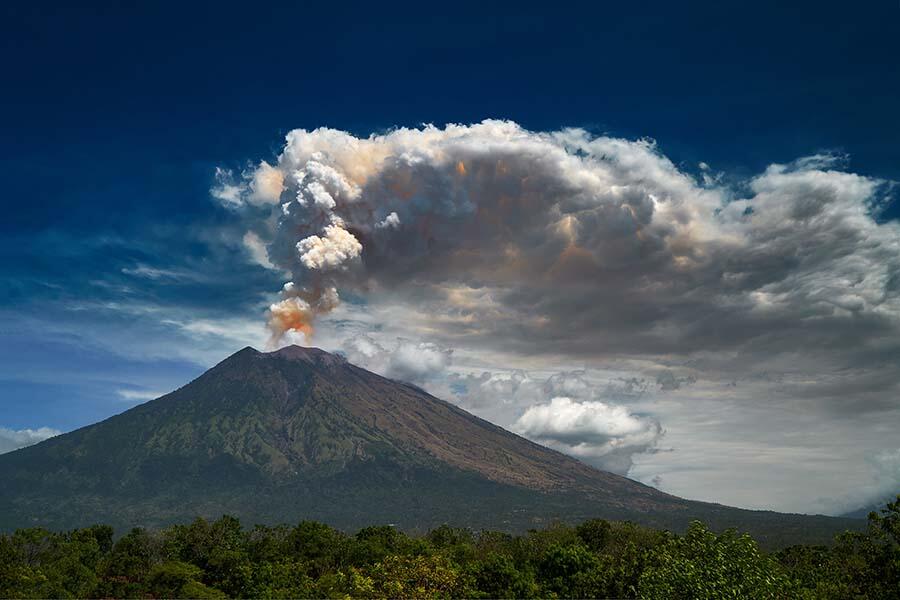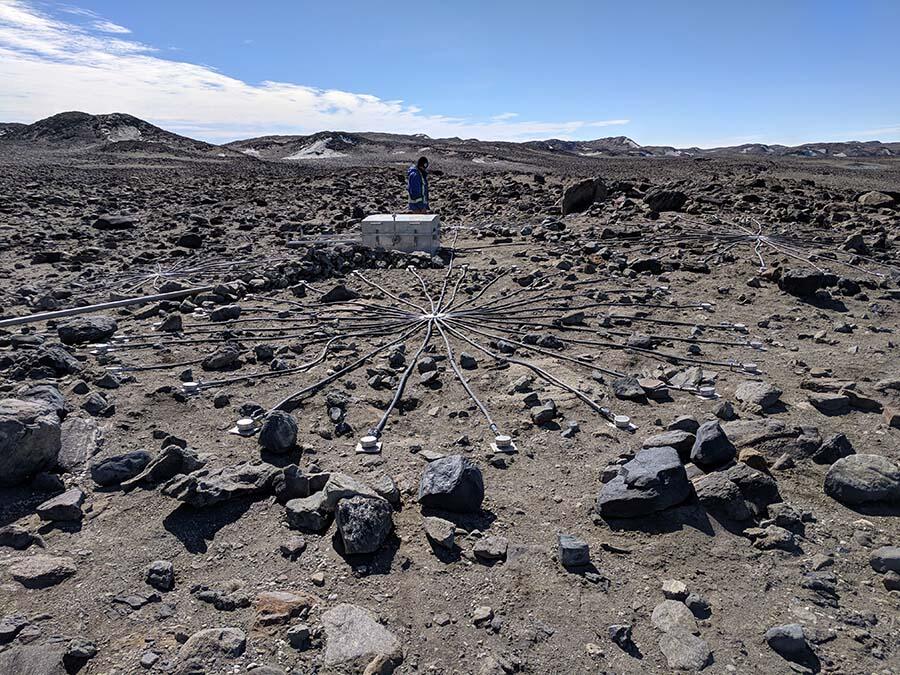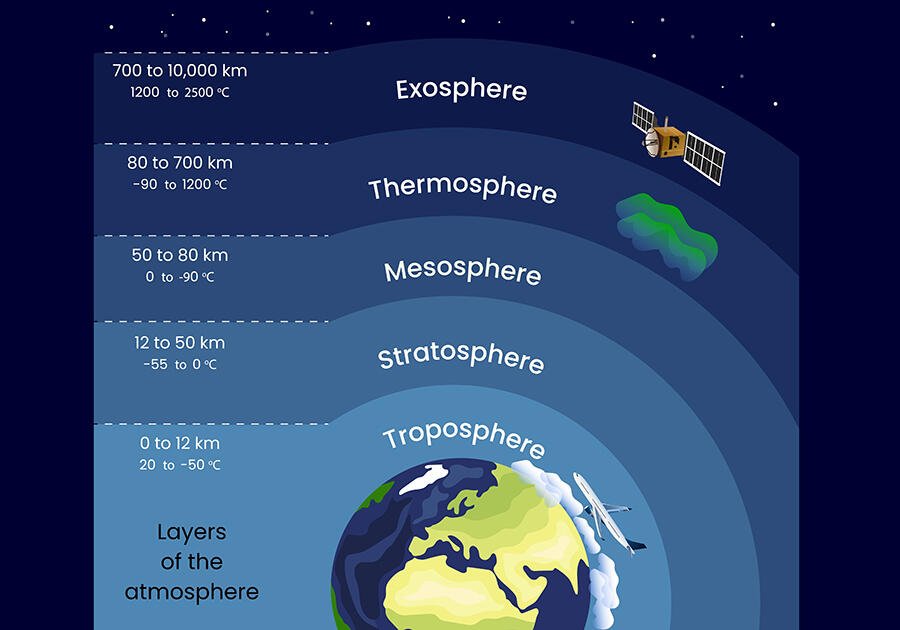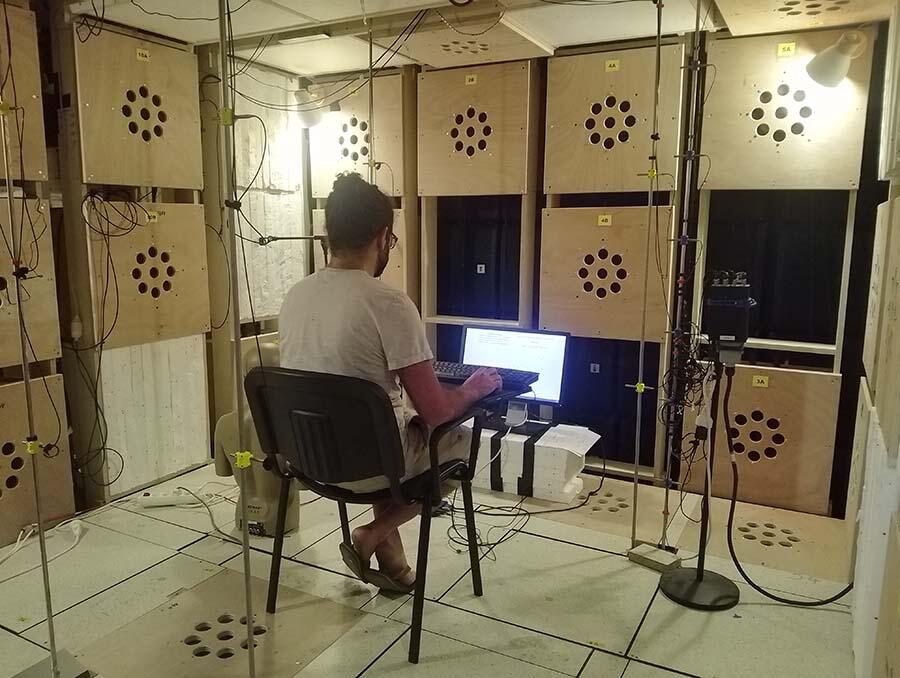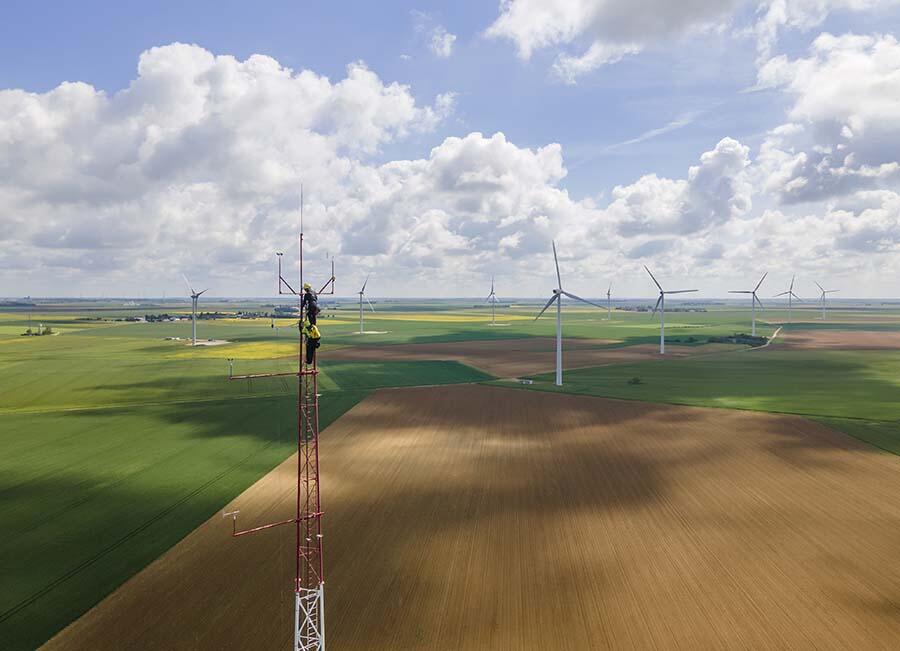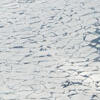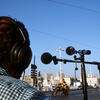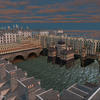You are here
Infrasound, sound waves that nothing can stop

Indonesia, 26 August 1883. Krakatoa awoke with a powerful explosion. The acoustic wave generated by the volcano was so intense that it was recorded by weather station barometers in London, over 10,000 kilometres away. “It was the first infrasound measurement ever made,” recounts François Coulouvrat, a physicist specialising in acoustics at the Jean le Rond d’Alembert Institute.1 “In London the wave was actually recorded twice, which means it travelled around the Earth at least two times.” Twenty years later, in 1908, the atmospheric entry of the large Tunguska asteroid and its astounding explosion–1,000 times more powerful than the bomb dropped on Hiroshima–was once again detected thousands of kilometres away. This gave rise to the interest of scientists in infrasound waves, very low-frequency acoustic waves below 20 hertz (Hz) that can propagate over great distances.
There is nothing magical about the phenomenon. An acoustic waves is a pressure wave—and hence a mechanical wave2—that propagates longitudinally by oscillating oxygen and nitrogen molecules in the air, creating slight overpressures and underpressures upon its passage. The wavelength corresponds to the distance between two maximums (or between two minimums) of pressure. However, the lower a sound wave’s frequency–as is the case with very low frequencies–the larger its wavelength, and the farther it will travel. It will also tend to be “blind” to obstacles smaller than its wavelength. Conversely, the higher the frequency (high-pitched sounds), the smaller the wavelength, and the more quickly it will be absorbed by the atmosphere and be affected by obstacles. This relation between frequency and wavelength is captured in a simple equation: wavelength (in meters) = speed of sound (340 meters per second on the ground) / frequency (in hertz)
Natural and industrial sources
“All geophysical phenomena emit infrasound: volcanic eruptions, earthquakes, falling meteorites, tornadoes, lightning, aurora borealis, etc.,” informs Roberto Sabatini, an academic at the Fluid Mechanics and Acoustics Laboratory in Lyon.3 “A volcanic explosion that generates, within the lower end of its sound spectrum, waves with a frequency of 1 millihertz (0.001 Hz) will have a wavelength of 34 km, more or less equivalent to the size of the emitting object. Ocean swells, a permanent source of infrasound, generate waves around 0.5 Hz, which corresponds to a wavelength on the order of a kilometre.” It should be noted that while frequency and wavelength are linked, the intensity of the sound waves produced depends on the nature and power of the source.
The emission of infrasound is nevertheless not limited to just geophysical phenomena. “We now know that numerous artificial sources produce infrasound acoustic waves, including nuclear and chemical explosions, the boom from supersonic airplanes, and any kind of industrial installation that moves air,” continues Sabatini. Pumps, ventilation systems, generators, and other wind turbines emit infrasound within frequency bands that tend to be closer to the 20 Hz threshold.

Another property of very low-frequency waves intrigued scientists very early on, namely their propensity to “play the invisible man.” “During the First World War, the general staff of the French army called on scientists to help locate the enormous German batteries by calculating the direction of their fire, its time of arrival, etc.,” adds Coulouvrat. “That led to an odd discovery, namely that the shots could be heard near the batteries, not at all a few dozen kilometres away, and then once again moving further away. The din of war could be heard all the way on English shores, without the inhabitants understanding where these muffled sounds were coming from.”
We should immediately dispel the myth that only elephants and whales can hear infrasound. Considered to be inaudible by humans, infrasound waves are indeed perceptible by each and every one of us, as long as sufficiently strong levels of intensity are reached (see below). “The crashing thunder we hear multiple kilometres away from the lightning is none other than the infrasound portion of the sound spectrum produced by the lightning; since the highest frequencies are absorbed, only the lowest frequencies remain,” explains Coulouvrat.
Yet how can an acoustic wave be heard, then seemingly disappear, only to once again be audible as distance increases? The late twentieth century saw a revival of interest in infrasound research, which helped reveal a second phenomenon, one that is essential to understanding why such waves seem to vary in intensity over large distances: refraction with altitude.
A global monitoring network
“While the supersonic boom of the Concorde,4 which generates significant infrasound, led to numerous studies, the great leap in infrasound research came from the global network of monitoring stations following the signing of the Comprehensive Nuclear-Test-Ban Treaty (CTBT) in 1996,” points out Sabatini. “In total 60 infrasound monitoring stations (one of the most recent coming into service in Guadeloupe in 2020), can detect secret nuclear tests anywhere on the planet due to the infrasound they emit.”

Thanks to the large quantity of observations gathered–infrasound stations, which register continuously, also detect all of the geophysical phenomena cited above–researchers have revealed the role played by the various layers of the atmosphere in the propagation of infrasound. When a source located on the ground emits an acoustic wave, it travels in all directions, close to the ground but also up towards the sky, where it can rise to an altitude of a hundred kilometres for very low frequencies. When travelling in the atmosphere, infrasound waves encounter an environment that is not homogenous, where temperature and wind patterns vary constantly. For example, up to 11 km of altitude (troposphere) the temperature drops, and then rises between 11 and 50 km of altitude (stratosphere), before falling once again in the mesosphere, and sharply increasing above 90 km (thermosphere).

Temperature directly effects the propagation speed of sound, as well as its direction. “When air heats up, that increases the speed of sound and deflects it vertically,” Coulouvrat goes on. “When it cools down, that decreases its speed and shifts it horizontally. Wind also has an influence. Depending on whether it is a tailwind or a headwind, it can accelerate or slow the sound wave, and also deflect its trajectory.” With these changes in direction, some of the sound waves emitted into the atmosphere end up falling back down to the ground.
“One can speak of sound wave packets,” says Sabatini. “At 250 km from the source, a distance that is characteristic for the infrasound emitted in the atmosphere, you will first receive a direct acoustic wave, and then a wave packet from the stratosphere (50 km), followed by a wave packet returning from the thermosphere (100 km).” Hence the more powerful emergence of sound at certain key distances.
Infrasound for characterising the atmosphere
While the phenomenon of refraction at altitude explains the variation in sound intensity over space and time, it also paves the way for unexpected applications. “The signal we receive at an infrasound station depends on the source and characteristics of the atmosphere,” Sabatini details. “Each source has a particular acoustic signature. So if we know the source, for instance a particular volcanic eruption or earthquake, we can deduce information on the characteristics of the atmosphere, especially the speed and direction of stratospheric winds, which we cannot directly measure, and that are central to improving climate models.”
The infrasound information received by stations in the CTBT network can also help improve the characterisation of earthquakes, and even offer alert signals. “With regard to submarine earthquakes that can generate tsunamis, we know that the tsunami wave travels slower than the sound wave in the atmosphere, so the latter could be detected before the tsunami reaches coasts, making it possible to warn inhabitants of the imminent wave. In reality, we have just begun to explore all of the possible uses of these infrasound signals.”
While infrasound is a promising research tool for physicists specialising in the atmosphere, it is also cause for concern on the ground, with the increase of potentially emitting industrial sources–with the notable rise of wind power–raising the issue of the human perception of infrasound waves, along with its potential health effects.
A novel infrasound booth in Marseille
A term has regularly appeared in global media over the last twenty years: “hum,” a mysterious sound that only a fraction of the population perceives. “ENT colleagues sometimes contact us on behalf of patients complaining about hearing low-frequency noise in their homes, whose origin they cannot identify, and which nothing seems to stop, not even earplugs,” recounts Paul Avan, a doctor and the Director of the Center for Research and Innovation in Human Audiology at the Pasteur Institute (CERIAH).



There have been few studies on the human perception of infrasound, but it has been formally acknowledged by scientists, for unlike what its name suggests (the prefix “infra” is in reference to human hearing), infrasound can indeed be perceived by the human ear. “It is widely accepted that humans hear in the frequency band between 20 Hz and 20,000 Hz, with extreme sensitivity around 100-200 Hz, corresponding to the basic frequency of the human voice, and up through 4,000 Hz,” indicates Sabine Meunier, a specialist on psychoacoustics at the Laboratory of Mechanics and Acoustics in Marseille5 (LMA). “However, these thresholds were established at a time when we knew little about very low frequencies. All of us can actually hear frequencies below 20 Hz at relatively high levels that are not common in everyday life, with our ears being less sensitive to very low frequencies.”
This is precisely what we are about to experience in the infrasound booth that Meunier’s team has just built in Marseille as part of the Ribeolh project (Research on the Impacts of Wind Turbine Noise on Human Health). This 40 cubic meter “box,” covered in loudspeakers from floor to ceiling, was specially designed to reproduce very low-frequency sounds of high intensity, up to 100 decibels. “In total 72 loudspeakers were installed, which can simultaneously diffuse frequencies ranging from 4 Hz to 3,000 Hz on 36 channels,” details Ossen El Sawaf, a postdoctoral fellow at the LMA. “Thanks to this instrument, we can diffuse wind turbine noise, which we know includes a great deal of infrasound,6 and more broadly expand our basic knowledge of the perception of very low frequencies,” specifies Meunier.
Three pure infrasounds are diffused at 20 Hz, 12 Hz, and 8 Hz, at varying levels of intensity. The feeling is surprising, for at such low frequencies, we no longer perceive a continuous sound (what acousticians refer to as a “tone”), just a regular beating. “For an infrasound to be audible, it must have a minimum intensity, which is known as the auditory threshold. This threshold is between 88-90 decibels (dB) for a 20 Hz sound, 100 dB for a 12 Hz sound, and 100 dB for 8 Hz.” The ear would perceive these levels of intensity as very loud for sounds emitted at higher frequencies, as 100 dB is the noise experienced in the cockpit of a race car!
Another distinctive feature that we experimented with in the booth is that within the infrasound band, all it takes is a few decibels to go from a sound that is barely audible to one that is perceived as being very loud. “In the frequency band that the human ear hears the best, a sound will be perceived as low at 20 dB, and as very loud at 80 dB. But at 20 Hz, going from 90 dB to 100 dB is all it would take to have this impression of a sharp increase,” Meunier adds. Thanks to the booth and the thirty volunteers she is hosting today, Meunier hopes to learn more about the auditory mechanisms linked to the perception of infrasound. “It has been established, for example, that a sound with a broader range of frequencies tends to be perceived as being louder than a pure sound. Is the same true for infrasound? We also know that a sound modulated in amplitude is perceived as being more bothersome than a continuous sound, independent of its intensity.”
Some are more sensitive than others
Paul Avan, who is also involved in the Ribeolh project, is trying to understand the auditory system’s reaction when it is exposed to infrasound. “I am going to measure the physiological changes that could be produced in the inner ear after exposure to infrasound. This is true in the vestibule, the part of the inner ear involved in balance, as well as in the cochlea, which is dedicated to hearing.” The cochlea is a spiral-shaped part of the inner ear behind the eardrum on which hearing cells are located: outer hair cells amplify the sound received, and inner hair cells transform it into an electrical signal transmitted to the brain. “The cochlea is a little like a piano. Higher sounds will excite only the bottom of the cochlea, and when the sounds are deeper, low frequencies will excite it along its full length, which is two and a half turns around the modiolus among humans,” explains Avan, who is focusing on whether an inaudible infrasound received by the inner ear actually excites the cochlea in the same way as an audible infrasound heard by the subject.7
In a second phase of the study, the doctor is planning to focus on people who are more sensitive to infrasound, those who are thought to have a somewhat lower auditory threshold than the population average, and that experience discomfort when others quite simply hear nothing. “We would like to identify the factors behind this difference in perception. Could an anatomical particularity, such as a slightly longer cochlea, be the cause? A disturbance of the endolymph, the liquid found in the inner ear, could also explain this greater sensitivity,” suggests Avan.
Improved prediction for noise from industrial installations
Yet there is a problem, for infrasound remains a blind spot in the regulations governing sound in numerous countries, including France. “In France, environmental noise is essentially measured in A-weighted decibels (dB A). This weighting system can account for the ear’s great sensitivity to certain frequencies by giving them more weight, with a view to assessing the actual discomfort caused by noise such as road traffic, circulating trains, or a concert. However A-weighting is not suitable for frequencies below 125 Hz, for it applies a filter that greatly reduces them,” points out David Ecotière, the Deputy Director of the Environmental Acoustics joint research unit8 (Umrae), and a specialist on outdoor sound propagation. “In general, when we researchers measure infrasound, we present our results in unweighted decibels.” Ecotière also draws attention to the often unsuitable equipment used by the engineering consultancies hired to conduct environmental noise assessments, equipment that does not have the requisite sensibility in very low frequencies.
He believes another weakness is that variability is not sufficiently accounted for in preliminary assessments for new industrial installations, wind farms in particular. “We know how much the topography of the site–as well as local atmospheric conditions such as wind, temperature gradient, and the nature of the soil (hard or soft, wet or dry)–impact the level of noise perceived by local residents.” Take for example a go-karting track, for which an expert assessment was conducted: the measurements taken at a local inhabitant living 800 m from the track revealed a 15 dBA difference depending on wind and temperature conditions for an equivalent sound emission.
“Headwinds tend to deflect sound waves towards the sky, while a tailwind will push them toward the ground and increase the noise level. The temperature gradient, or the difference in temperature between the ground and the air, will also deflect the sound wave, or on the contrary push it downward,” elaborates Ecotière. For instance at nighttime, when there are thermal inversions between the ground and the air, sound generally tends to be pushed toward the ground, thereby increasing the noise level around the sound source. “This is true for both high frequencies and infrasound.”

With their blades measuring 50 m in length–a total span of 100 m–wind turbines are a special case. Due to their dimensions, such installations can be simultaneously exposed to different wind and temperature conditions. This makes noise prediction models particularly difficult, reminds Ecotière, who since 2018 has coordinated the vast Predicting the Impact of Wind Turbine Noise (PIBE) project. “We continuously recorded a field of eight wind turbines for 410 days at different distances, and under all possible atmospheric configurations.” A unique database enabling better prediction of wind farm noise–notably by including the notion of variability (+ or – a certain number of decibels for a particular sound level9)–will be made available to the scientific community.
In the meantime, these in situ recordings were sent to Meunier and her colleagues, who will diffuse them in the LMA’s infrasound booth in Marseille in order to enhance our knowledge of how very low-frequency infrasound is perceived, and shed more light on these understudied acoustic waves. “Infrasound tends to stimulate the imagination. We cannot see it, most of the time we cannot hear it, and its propagation over long distances makes identifying its source difficult at times,” Ecotière concludes. “But it has an impact on health, and the legislation governing noise and applicable standards should therefore change considerably.
- 1. CNRS/Sorbonne Université.
- 2. Unlike electromagnetic waves, which can propagate in a vacuum.
- 3. CNRS/Centrale Lyon/Insa Lyon/Université Claude Bernard Lyon 1.
- 4. The Concorde was the supersonic airliner operated by Air France and British Airways between 1976 and 2003. The boom it caused in flight resulted in it being banned from flying over the United States.
- 5. CNRS/Aix-Marseille Université/Centrale Méditerranée.
- 6. Wind turbine noise has a wide range of frequencies, from less than 10 Hz to more than 3,000 Hz. It is a “pink” noise that is more intense in infrasound and low frequencies than in higher ones.
- 7. In connection with the Ribeolh project, a noise impact study and an epidemiological study will also be conducted to determine whether wind turbine noise impacts health.
- 8. Université Gustave Eiffel/Cerema.
- 9. A tool will soon be available on the PIBE project website (https://www.anr-pibe.com/(link is external)) to estimate a wind farm’s sound variability.



